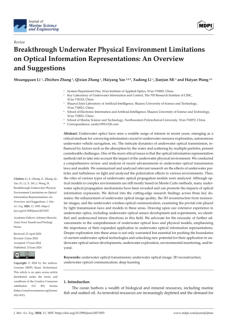

Studies of ROV concepts 2023 to now


Authors: Jiafeng Huang, Hyeung-Sik Choi, Dong-Wook
Jung, Ki Beom Choo, Hyunjoon Cho, Phan Huy
Nam Anh, Ruochen Zhang, Joon Young Kim,
Daehyeong Ji, Jung-Hyeun Park
The “twin hybrid autonomous underwater vehicle” is a
novel unmanned underwater platform consisting of a
twin torpedo-shaped hull actuated by two buoyancy
engines and two thrusters. It was designed to have faster
speed generated by the two buoyancy engines and two
thrusters. The two buoyancy engines on each hull and
the airfoil are mainly responsible for the diving and
surfacing motion, and the thrusters drive it along the
horizontal plane. It can carry more instrumentation and
energy than a conventional hybrid autonomous
underwater vehicle and perform more exploration tasks
for extended periods.

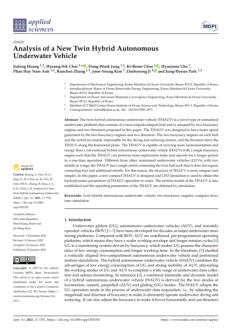

Authors:
Simon Siregar, Bambang Riyanto Trilaksono, Egi
Muhammad Idris Hidayat, Muljowidodo Kartidjo, Natsir
Habibullah, Muhammad Fikri Zulkarnain, and Handi
Nugroho Setiawan
The main goal of this paper was to design and construct a
hybrid autonomous underwater glider (HAUG) with a
torpedo shape, a size 230 cm in length and 24 cm in
diameter. The control, navigation, and guidance system
were executed simultaneously using a Udoo X86
minicomputer as the main server and three BeagleBone
Black single-board computers as the clients. The
simulations showed a controlled horizontal speed of 0.5
m/s in AUV mode and 0.39 to 0.51 m/s in glide mode
with a pitch angle between 14.13 deg. and 26.89 deg.



Authors: Shohei Hotta, Yusuke Mitsui, Mizuki Suka,
Norimitsu Sakagami, and Sadao Kawamura.
This paper reports the development of a lightweight
remotely operated vehicle that performs underwater
excavation work for archaeological surveys.
Discovering underwater artifacts is generally difficult
because they are often covered with sediment in high-
risk areas. To find them, divers and large remotely
operated vehicles must conduct excavation work with
manipulators. Nevertheless, accomplishing such tasks
is difficult for small underwater robots without a
manipulator. For this reason, the authors developed a
lightweight underwater robot of 35 kg that can remove
sediment from the seabed or lake bottom using its
thrusters instead of a manipulator.

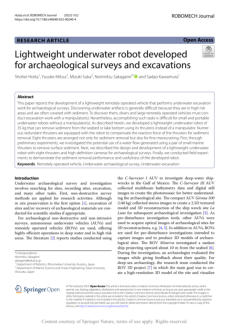

Authors: Kaveripakam Sathish, Ravikumar Chinthaginjala
Venkata, Rajesh Anbazhagan, & Giovanni Pau
Oceanographic data collection, disaster prevention, aided
navigation, critical observation sub-missions, contaminant
screening, and seaward scanning are just a few of the
underwater sensor hub submissions. Unmanned
submerged vehicles (USVs) or autonomous acoustic
underwater vehicles (AUVs) through sensors would
similarly be able to explore unique underwater resources
and gather data when utilized with integrated screen
operations. The most advanced technological method of
oceanic observation is wireless information routing
beneath the ocean or generally underwater.

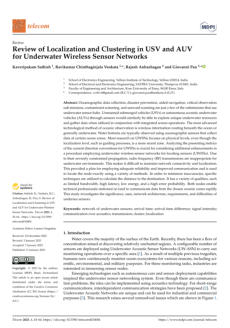

Authors: Qiyun Cheng, Wenyuan Mo, Long Chen,
Wei Ke, Jun Hu, and Yuwei Wu.
Underwater robotics is rapidly evolving due to the
increasing demand for marine resource exploitation.
Compared with rigid robots using propellers, bionic
robots are stealthier and more maneuverable, such as
autonomous underwater vehicles (AUVs) and remotely
operated vehicles (ROVs), making them widely used
underwater. To study the motion state of the umbrella
jellyfish bionic robot, the displacement of the jellyfish robot
along the same direction and the surrounding fluid
pressure distribution caused by the jellyfish motion under
different experimental conditions are discussed in this
paper.

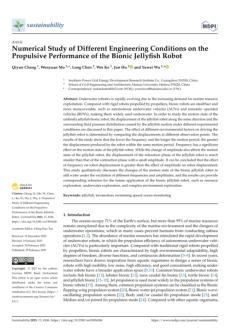

Authors: Thierry Soriano, Hoang Anh Pham, &
Valentin Gies.
This study presents a relative localization estimation
method for low-cost underwater drones (l-UD), which
only use visual feedback from an onboard camera and
Inertial Measurement Unit (IMU) data. It aims to design
a distributed controller for a group of robots to reach a
specific shape. This controller is based on a leader-follower
architecture. The main contribution is determining the
relative position between the low-cost underwater drone
without using digital communication and sonar
positioning methods.

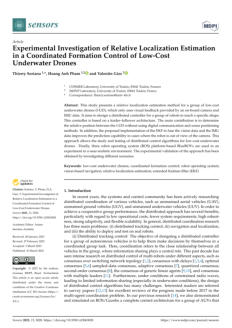

Authors: Zhiyong Duan, Yurui Zhang, Jiaqi Hu, Bohao
He, and Canjun Yang
At present, contact watertight connectors are commonly
utilized for the connection between underwater
electromechanical equipment and the seabed observation
network. Such traditional watertight connectors are easy
to be irreversibly worn when plugging and unplugging,
however, they have complicated sealing structures and
limited service life.
This paper designs a Non-contact Wet Mateable
connector for Optical Communication and Power
Transmission (OCPT-NWMC), which is based on
technology of Contactless Power Transmission (CLPT) and
optical communication.

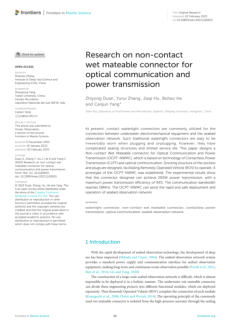

Authors: Shinsuke Kawagucci, Yohei Matsui, Hidetaka
Nomaki, and Chong Chen
Recovery of samples from the deep ocean in pristine
condition is diffficult due to large environmental
differences between the deep and surface waters through
which the samples necessarily must be transported. The
authors propose a concept for deep-sea sample recovery:
a deep-sea freezer using thermoelectric cooling capable of
generating ice in the deep and recover them frozen on-
board ships.

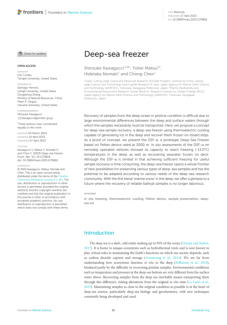

Authors:
Celine Tran, Ivan Gushkov, Kristoffer Nordvik, Simen T.
Røang, Simen B. Lysthaug, Babak Ommani, Thor I. Fossen,
Vahid Hassani, Vidar Smines, Tor A. Johansen
The launch and recovery of equipment such as
remotely operated vehicles (ROVs) is a critical task that
defines the operability limits of many marine operations.
This paper considers the analysis of control systems that
are designed to maximize the operability limits for launch
and recovery of a ROV from a small unmanned surface
vessel (USV).

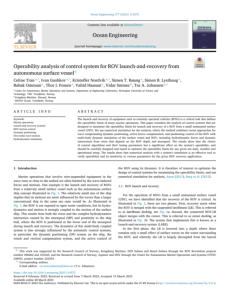

Authors: Fauzal Naim Zohedi, Mohd Shahrieel Mohd
Aras, Hyreil Anuar Kasdirin, Mohd Bazli Bahar,
& Lokman Abdullah
The underwater environment makes it hard for ROV
operators to control the manipulator while holding
position simultaneously. This led to modelling and
controller design for the vertical trajectory of ROV.
In this paper, the System Identification (SI) modeling
technique was used to model the vertical trajectory of
the ROV. Then, the Proportional, Integral, and Derivative
(PID) controller was implemented to control the trajectory.



Authors: Gaofei Xu, Daoxian Zhou, Libiao Yuan, Wei Guo,
Zepeng Huang, and Yinlong Zhang
Autonomous underwater vehicles (AUVs) equipped
with online visual inspection systems can detect
underwater targets during underwater operations, which
is of great significance to subsea exploration.
However, the undersea scene has some instinctive
challenging problems, such as poor lighting conditions,
sediment burial, and marine biofouling mimicry, which
makes it difficult for traditional target detection algorithms
to achieve online, reliable, and accurate detection of
underwater targets.



Authors:
Uday Chandrakant Patkar, Megha Patil, Aditya handhoke,
Abhijeet Jain, Muskan Kumari, Namokar Jain,
shikha Bhardwaj, Uday Shankar Patil
The authors present a solution of an underwater ROV
(Remotely operated Vehicle) in which theyl fit the
camera to detect the human body in optimal time. For
underwater operations, computer vision is one of the
most important technologies. For an Underwater
environment, weak lighting, and dissolved particles are
tough for a pre-processing procedure, which is
necessary for underwater vision.

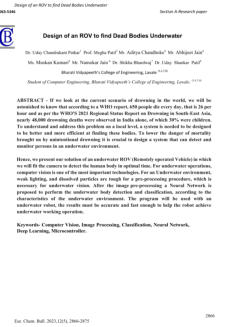

Authors: Yangfan Cui, Peibin Zhu, Guowei Lei, Peng
Chen, & Guangsong Yang
To solve the problems of limited energy and the difficulty
of battery replacement in UWSN, a path planning and
energy-saving scheme for charging underwater sensor
nodes using AUVs (autonomous underwater vehicles) is
proposed.
Applying multiple AUVs to charge the sensing network
nodes will maximize the size of the underwater sensing
network as well as meet the transmission reliability, and
the optimal path of AUVs is solved by using a genetic
algorithm.

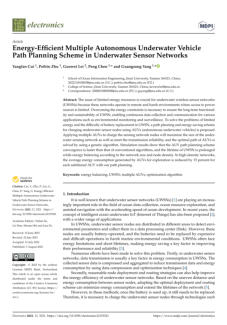

Authors:
Yong Zhang, Feihu Zhang, Zhiliang Wang, & Xiaofang
Zhang
The authors propose a precise underwater dead-
reckoning mathematical model that recursively calculates
the ground truth and corresponding errors based on an
AUV’s motion model, and we derive empirical formulas.
Compared to related methods, this approach not only
models the cumulative errors of relative noise
measurements, but also provides recursive expressions
with corresponding statistical moments. The experimental
results demonstrate that this formula significantly reduces
positioning errors in underwater navigation tasks.

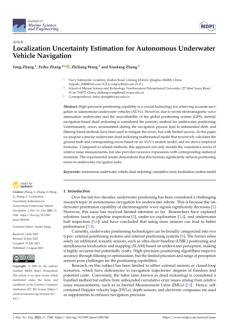

Authors:
Yeming Zhang, Demin Kong, Yan Shi, Maolin Cai, Qihui
Yu, Shuping Li, Kai Wang, & Chuangchuang Liu
The main focus of this paper is to classify different types
of underwater organisms according to their common
motion modes, focusing on the achievements of some
bionic mechanisms in different functional fields that have
imitated various motion modes underwater in recent
years (e.g., the underwater sucking glove, the underwater
Gripper, and the self-powered soft robot).
The development of various task types (e.g., grasping,
adhesive, driving or swimming, and sensing functions)
and mechanism realization forms of the underwater
soft robot are described based on this article.



Authors:
Gongbo Li , Guijie Liu, Dingxin Leng, Xin Fang,
Guanghao Li, & Wenqian Wang.
This paper classifies the existing underwater biomimetic
robots and outlines their main contributions to the field.
The propulsion mechanisms of underwater biomimetic
undulating robots are summarized based on theoretical,
numerical and experimental studies. Future perspectives
on underwater biomimetic undulating robots are also
presented, filling the gaps in the existing literature.

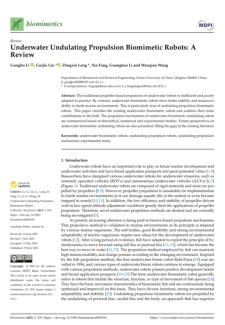

Authors: Yuhang Tang, Xueren Wang, Xuhong Miao,
Shengyao Gao, Bing Li, and Zilong Peng
This study presents an optimization algorithm for
achieving optimal acoustic stealth performance when
designing an underwater vehicle in the free field using
COMSOL-MATLAB integrated software. A component
superposition method, based on phase interference, is
adopted to simplify and decompose a non-
axisymmetric complex underwater vehicle model into
two main parts: the hull and the conning tower. The
shape of the underwater vehicle hull is described
mathematically with a sequence of undetermined
coefficients for optimization.

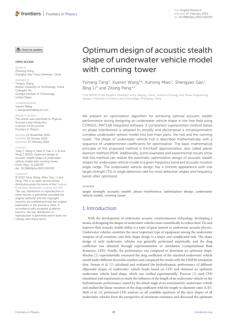

Authors: Ya Xie, Afei Zhu, and Zhonghua Huang
The control performance of fixed-depth motion is related
to the performance of the underwater vehicle.
Due to the complex and changing underwater
environment, various potential risks, the variety of
underwater operations, and the variability of structural
parameters and environmental parameters of the
underwater vehicle, the control performance is
compromised when performing constant depth motion.

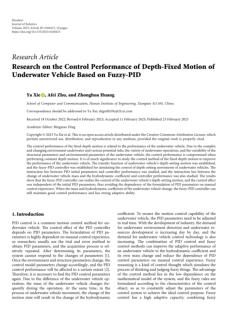

Authors: Xinhui Zheng, Qiyan Tian, and Qifeng Zhang
Underwater vehicle-manipulator systems (UVMS) have
played an increasingly important role in ocean exploration.
To realize precise operation in underwater narrow spaces,
the fly arm underwater vehicle manipulator system
(FAUVMS) is proposed with manipulators as its core.
However, this system suffers from severe dynamic
coupling effects due to the combination of a small vehicle
and large manipulators.
The authors propose a robust adaptive controller to
resolve this issue.

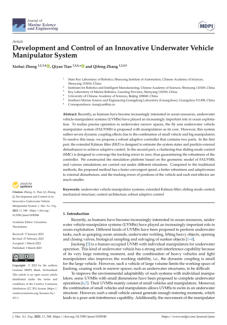

Author: Krzysztof Naus
This paper presents the results of research on the
accuracy assessment of the positioning of a swarm of
underwater vehicles based on hydroacoustic
measurements made with respect to four surface
vehicles under the time difference of arrival (TDOA)
method.
The assessment consisted of the estimation of accuracy
parameters for determining the position of an
underwater vehicle in relation to surface vehicles that
form a so-called moving geometrical measurement
structure (MGMS).

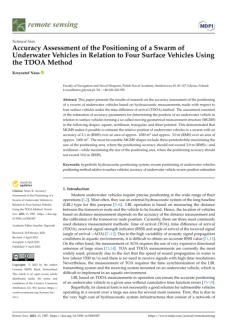

Authors: Stefano Brizzolara, Alan Brown, Craig Woolsey,
Daniel J. Stilwell
This thesis proposes a method to simulate the dynamics of
an autonomous underwater vehicle towing another
autonomous underwater vehicle of equivalent size using
a marine cable in the vertical and horizontal planes. There
is a coupling effect between the two vehicles because the
towed vehicle is of equivalent size. This means that the
towed vehicle cannot be modeled as just a payload but
rather must incorporate the forces and moments
experienced and acting upon it. In this work, only AUVs
with symmetrical hulls are considered, where the towing
AUV moves at a constant velocity with a set thrust, while
the towed AUV has no thrust.

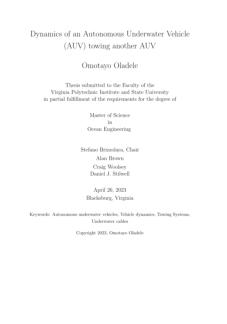

Authors: Shuangshuang Fan, Xinyu Zhang, Guangxian
Zeng, and Xiao Cheng)
The undersides of floating ice shelves and sea ice in the
Antarctic and Arctic are among the least accessible
environments on Earth. The interactions between ice
shelves, sea ice, and the ocean are of considerable
scientific interest. In order to fully understand the complex
picture of sea ice, and not just its surface, it is necessary to
map the underside to comprehend the full context of its
growth and decay patterns.
Autonomous Underwater Vehicles (AUVs) are rapidly
becoming the desired platform of choice for mapping
the underside of sea ice to provide high-resolution 3D
views of sea ice topography.



Authors: Dan Zou, Fei Zhao
Many underwater missions must be carried out with
stealth to avoid being detected by enemy sonars, and
safety and security are required in such high-risk
situations. In this paper, a covert path planning
algorithm for underwater vehicle is proposed based
on the sonar detection probability analysis.



Authors: Ping Hu, Dawen Jiao , Jiahui Qi and Sidi
Chen
Due to incomplete data collection, the difficulty of locating
the source of the static magnetic field data for
underwater vehicles increases. Therefore, it is necessary to
study the influence of data loss on the static magnetic
source location of underwater vehicles and the field
source location for timely remediation of missing data. In
this paper, the static magnetic equivalent source model of
the underwater vehicle was established. Then, the
inversion positioning algorithm was used to locate the
magnetic field source of the underwater vehicle obtained
from the test, and the influence of the location result
under incomplete data information was analyzed.



Authors: Yuzhe Wang, Pengpeng Zhang, Hui Huang,
and Jian Zhu
Jellyfish are among the most widely distributed creatures
that can effectively control the fluid flow around their
transparent soft bodies, thus achieving movement in
water and camouflage in their surrounding environments.
Until now, it has remained a challenge to replicate both
the transparent appearance and functionalities of nature
jellyfish in synthetic systems due to the lack of transparent
actuators. In this work, a fully transparent soft jellyfish
robot has been developed to possess both transparency
and bio-inspired omni-motionin water.

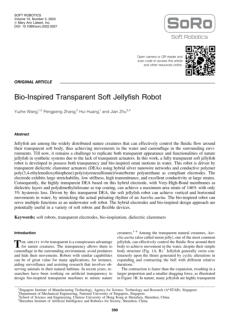

Authors: Yulin Deng, Xiudi Ren, Martin Nuernberg,
Longbin Tao
ROV often experiences excessive motion as it passes
through the wave zone due to wave-ROV interaction
combined with free surface effects.
These movements can cause rope slack and sudden
loading, which may damage umbilical components and
endanger ROV operation.
This study focuses on experimental measurements and
numerical predictions of the dynamic tension in the
umbilical during the launch and recovery of the ROV.

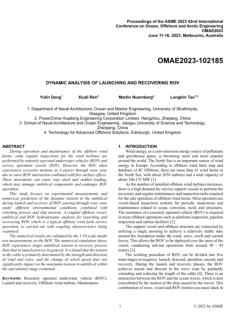

Authors: Xiaodong Liu, Yuli Hu, Zhaoyong Mao, and
Wenlong Tian
Unmanned Underwater Vehicles (UUV) face
maneuverability and rapidity challenges when they are
applied for detecting and repairing submarine oil and gas
pipelines, and fiber cables near the seabed.
This research establishes numerical models of the bare
UUV and self-propelled UUV near the seabed using the
computational fluid dynamics (CFD) method. The effect of
dimensionless distance Hd and ReL on the hydrodynamic
performance of the vehicle and the interaction between
the hull and the propeller is investigated.

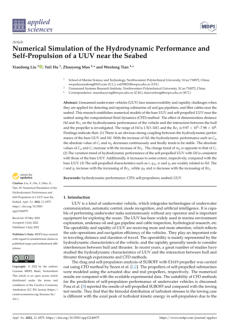

Authors: Mengzhuo Liu, Jifeng Zhu, Xiaohe Pan, Guolin
Wang, Jun Liu, Zheng Peng, and Jun-Hong Cui
Underwater vehicles play a crucial role in various
underwater applications, such as data collection in
underwater sensor networks, target detection and
tracking, and underwater pipeline monitoring. Real-time
acquisition of their states, particularly their location and
velocity is vital for their operation and navigation.
Consequently, the development of a remote tracking
system to monitor these states is essential. In this paper, we
propose a system that can track the underwater vehicle’s
location and velocity.

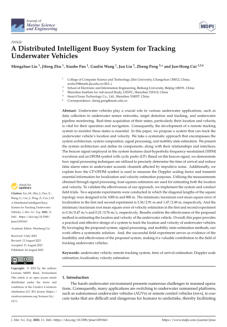

Authors: Mahfuzul Huda, Kumar Rohit, Bikramjit Sarkar,
and Souvik Pal
An imaginative technique is proposed that addresses
the nature of underwater images by eliminating
shadows and poorly differentiated relics that are normally
tracked in them. The most common methods of capturing
underwater images, resolution, reflection, and capture are
affected by various lighting effects.
These effects can make your photo weaker or covertly
louder. Improvement strategies are needed to overcome
these degrading factors. This post presents a procedure,
with example calculations, to handle the nature of
submerged images, using a generic histogram with
limited contrast.

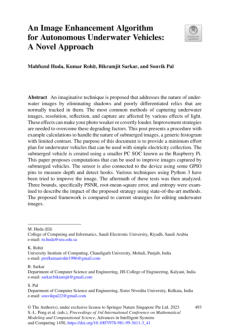

Authors: Hasnain Munir, Shabahat Hasnain Qamar,
Sara Khan, Adrian David Cheok, Haider Ali,
Muhammad Shoaib
Remotely Operated Underwater Vehicles (ROVs) are
an emerging technology for ocean research,
environmental and geochemical studies, mine hunting,
surveillance, and commercial use. Due to their
affordability, simplicity in handling and deployment,
appropriateness for deep-sea diving, increased mobility,
and ability to operate in harsh settings, underwater
vehiclesboth autonomous and remotely controlled - have
grown in popularity. The goal is to develop and test a
remotely operated underwater vehicle (ROV) that is
lightweight, affordable, and capable of conducting
surveys in shallow waters.



Authors: Fushen Ren, and Qing Hu
Underwater robots play a vital role in the exploration
and development of marine resources and the inspection
and maintenance of offshore platforms. This paper studies
the motion control, kinematics, and dynamics of ROVs.
The kinematic and dynamic models of ROVs have been
established, and the degrees of freedom of the models
according to the control requirements.



Authors: Zexin Zhao
This paper first introduces the significance and
application value of underwater vehicles, then briefly
enumerates the current research status and
application fields of autonomous small underwater
vehicles, and puts forward the prospect of its future
development trend. Finally, the progress in the
research and development of small autonomous
underwater vehicles, the existing shortcomings, and
the necessity of continuing to develop high-quality
small autonomous underwater vehicles are summarized.

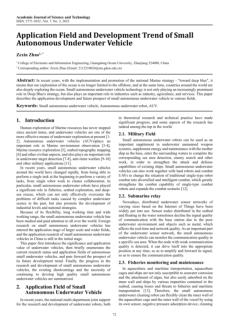

Authors: Tianlei Wang, Fei Ding and Zhenxing Sun
Human intelligence has the advantage for making
high-level decisions in the remote control of underwater
vehicles, while autonomous control is superior for
accurate and fast close-range pose adjustment.
Combining the advantages of both remote and
autonomous control, this paper proposes a visual-aided
shared-control method for a semi-autonomous
underwater vehicle (sAUV) to conduct flexible, efficient,
and stable underwater grasping. The proposed method
utilizes an arbitration mechanism to assign the authority
weights of the human command and the automatic
controller according to the attraction field (AF) generated
by the target objects.



Authors: Hongbo Li, Aijun Liu, Qiang Yang, Changjun Yu,
and Xuguang Yang
This study proposes a method to extend the virtual
aperture of the small aperture high-frequency surface
wave radar multi-element array, inspired by a fly named
Ormia ochracea. Despite the tremendous incompatibility
between its ear and the incoming wavelength, Ormia can
accurately locate the sound of its host cricket. This ability
benefits from the coupled structure of Ormia’s ears, which
has been modeled as a mechanical vibration system.

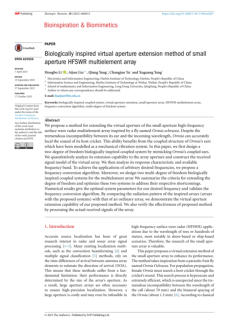

Authors: Jimin Hwang, Neil Bose, Gina Millar, Craig Bulger,
and Ginelle Nazareth
Autonomous underwater vehicles (AUVs) have been
applied in various scientific missions including
oceanographic research, bathymetry studies, sea mine
detection, and marine pollution tracking.
The authors designed and field-tested in the ocean a
backseat driver autonomous system for a 5.5 m survey-
class Explorer AUV to detect and track a mixed-phase oil
plume.

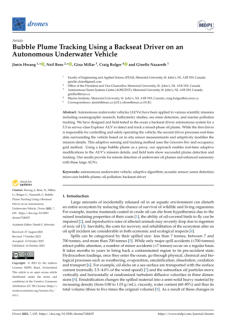

Authors: Edosa Osa, Daniel Chinemelem Samuels
This paper describes the design of a control system for
an autonomous Underwater vehicle EDYSYS 1. An
autonomous underwater vehicle is an unmanned and
self-propelled underwater vessel that can operate
independently underwater and carry out several missions
as assigned to it, compared to a Remotely Operated
Vehicle (ROV), which is usually tethered to a ship or some
other moored water vehicle. Intelligent design of control
systems for autonomous underwater vehicles is an active
area of research, given the demands for autonomy and
the capacity for intelligent systems to satisfy such
demands.

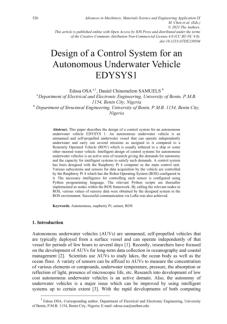

Authors: Rafał Kot
The underwater environment introduces many limitations
that must be faced when designing an autonomous
underwater vehicle (AUV). One of the most important
issues is developing an effective vehicle movement control
and mission planning system. This article presents a global
trajectory planning system based on a multimodal
approach.



Authors: Fernando Gómez-Bravo, Alejandro G
arrocho-Cruz, Olga Marín-Cañas, Inmaculada
Pulido-Calvo, Juan Carlos Gutierrez-Estrada,
and Antonio Peregrín-Rubio
This article introduces a control architecture designed
for the development of Hybrid Remotely Operated
Underwater Vehicles. The term ”Hybrid” characterizes
remotely operated systems capable of autonomously
executing specific operations. The presented architecture
maintains teleoperation capabilities while enabling two
fully autonomous applications. The approach emphasizes
the implementation of reactive navigation by exclusively
utilizing data from a Mechanical Scanned Imaging Sonar
for control decisions.

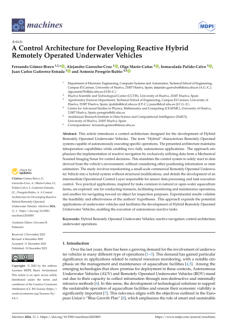



Click on the
octopus to return to
the top of the page

Authors: Christophe Vie, Juliette Drupt, Claire Dune,
Vincent Hugel
The umbilical of Remote Operated Vehicle (ROV) allows
transmitting information in real-time or energy supply to
the robot. However, it also has many disadvantages, such
as entanglement or the difficulty of predicting its shape,
which raises the question of being able to do without it.
To turn these constraints into advantages, this paper
proposes a method to estimate an ROV's position by
observing its umbilical shape.



Authors: Wenjie Lu, Kai Cheng, and Manman Hu
This paper introduces a model-free RL method that uses
Data-informed Domain Randomization (DDR) to control
AUVs. It minimizes mismatches between simulation
trajectory data and real AUV data by tweaking simulated
AUV parameters. DDR improves on adaptive domain
randomization by adding a network that learns to map
control signals across different domains, helping the
controller adjust to sudden dynamic changes.

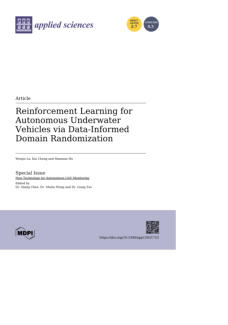

Authors: Tingzhuang, Liu Xinyu, He Linglu, He Fei Yuan
Drowning is a significant public health issue. Detecting
drowning through video is helpful, but there are
challenges like lack of real incidents to use as data and
early signs being hard to see. This study introduces an
underwater device with AI, cameras, and a waterproof
casing to solve these issues.

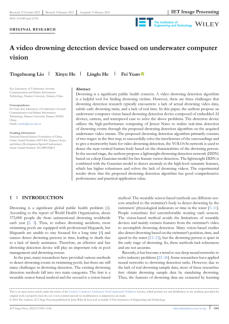

Authors: Chinonso E. Okereke, Mohd Murtadha
Mohamad, Nur Haliza Abdul Wahab, Olakunle
Elijah, Abdulaziz Al-Nahari, and S.Zaleha
The main goal of this paper is to give a rundown of the
latest machine learning (ML) techniques used in local path
planning for AUVs. It discusses ML algorithms categorized
under supervised, unsupervised, and reinforcement
learning. It also dives into the challenges of real-life
deployment, simulated scenarios, computational issues,
and how ML algorithms are applied, wrapping up with
some future research directions.

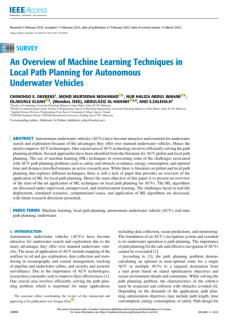

Authors: Vanesa Lopez-Vazquez, Jose Manuel Lopez-
Guede, Damianos Chatzievangelou, and Jacopo
Aguzzi
This study aims to automatically classify marine species
based on images obtained from deep-sea environments.
The image enhancement process primarily uses a
convolutional residual network, which generates
enhanced images from a set of raw images.

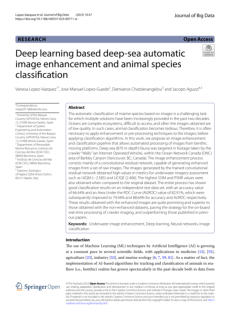

Authors: Alberto Monterroso Muñoz, Maria-Jose Moron-
Fernández, Daniel Cascado-Caballero, Fernando
Diaz-del-Rio, and Pedro Real
This study examines the synergistic effect between
professional photography and scientific fields by exploring
issues related to image acquisition. It also discusses
underwater image enhancement, quality assessment, and
image mosaicking, addressing algorithmic concerns as the
final processing step to pinpoint critical issues in AUVs,
covering the entire process from optical issues in image
sensing to challenges in algorithmic processing.

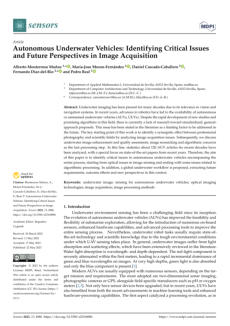

Authors: Zhaorui Gu, Xiuhan Liu, Zhiqiang Hu, Guoyu
Wang, Bing Zheng, John Watson, and Haiyong
Zheng
Optical imaging technology is crucial for underwater
research, but it faces challenges with light transmission.
Underwater computational imaging, which blends optical
design with signal processing, can enhance resolution
and usability. However, it often adapts techniques meant
for air to water, missing targeted research on crucial
needs and technology. It is essential to define the benefits
of underwater imaging technology's benefits and explore
its potential in complex scenarios to achieve significant
advancements.

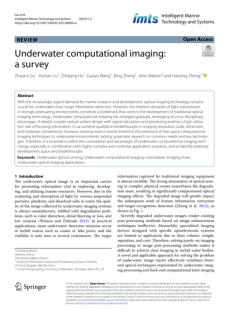

Authors: Abdelhakim Amer, Olaya Álvarez-Tuñón, Halil
Ibrahim Ugurlu, Jonas le Fevre Sejersen, Yury
Brodskiy, and Erdal Kayacan
Underwater robotic surveys can be costly due to the
challenging environment and the requirement for various
sensors. However, many simulators lack high-quality
rendering, which limits their real-world application. UNav-
Sim is the first simulator to use Unreal Engine 5, a series of
3D computer graphics game engines developed by Epic
Games, for detailed rendering that allows researchers to
build and test underwater algorithms.

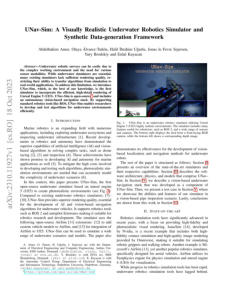

Authors:
Guangyuan Liu, Nguyen Van Huynh, Hongyang Du,
Dinh Thai Hoang, Dusit Niyato, Kun Zhu, Jiawen Kang,
Zehui Xiong, Abbas Jamalipour, and Dong In Kim
Advances in AI and robotics have increased interest in
swarms of unmanned vehicles for tasks that are too risky
for humans.
However, managing and coordinating these swarms in
dynamic settings poses significant challenges for
traditional AI methods. Generative AI (GAI) could be a
game-changer here, given its ability to handle complex
data. This paper surveys the applications, challenges, and
opportunities of GAI in unmanned vehicle swarms.

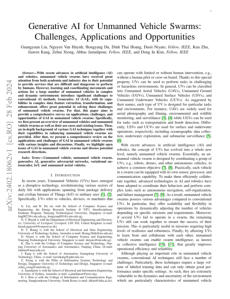


Authors: Artur Babiarz, Robert Bieda, Tomasz Borowik,
Tomasz Grzejszczak, Tomasz Hartwig, Krzysztof
Jaskot, Andrzej Kozyra, & Piotr Sciegienka
This document describes the design and features of a five
degrees of freedom (5DoF) underwater manipulator
system, outlining the key components and functionalities
of the system, including the solution of forward and
inverse kinematics problems, the implementation of a
system that mimics human arm movements using sensors,
and the inclusion of a simple haptic feedback device for
gripper control. It presents a new approach to designing a
robot control system for underwater applications,
emphasizing the reduction of system complexity and
distinguishing it from existing solutions.



Authors: Astrid Marie Skålvik, Camilla Saetre, Kjell-Eivind
Frøysa, Ranveig N. Bjørk, & Anders Tengberg
This document provides an overview of the challenges
and limitations associated with deep-sea sensor data and
proposes a solution involving automatic tests for sensor
self-validation and self-diagnostic capabilities to enhance
the reliability and accuracy of data collected by sensors in
remote deep-sea environments, which is crucial for long-
term autonomous operations and accurate deep-sea
observations. The document also emphasizes the
importance of data quality and the potential issues arising
from faulty sensor data, particularly in large-scale wireless
sensor networks.


Authors: Pengyun Chen, Ying Liu, Xiaolong Chen, Teng
Ma, Lei Zhang
This paper presents and validates a new method for
underwater terrain-matching positioning using a Markov
random field model. By leveraging real-time terrain data
from a multi-beam echo sounder, the method aims to
improve the accuracy and adaptability of autonomous
underwater vehicle navigation. The article also highlights
the successful results from playback simulation tests,
indicating the method's effectiveness in correcting
cumulative errors in inertial navigation systems and its
potential applicability in underwater engineering.

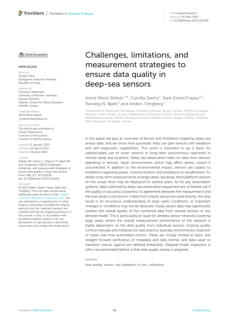


Authors:
Aryan Anand, M. Yuva Bharath, Prabha Sundaravadivel, J.
Preetha Roselyn, and R. Annie Uthra
This study introduces and describes a new approach to
underwater exploration that integrates Artificial
Intelligence (AI) with Autonomous Underwater Vehicles
(AUVs). It highlights the benefits of combining AI with
biomimicry to enhance the capabilities of AUVs, enabling
them to emulate the efficient and graceful movements of
marine creatures. The text outlines the development of a
new propulsion system inspired by marine organisms,
specifically cuttlefish, and discusses the advantages of this
system in terms of energy efficiency and reduced
environmental impact.



Authors: Fomekong Fomekong Rachel Merveille, Baozhu
Jia,and Zhizun Xu
This presentation discusses advancements in underwater
navigation for Unmanned Underwater Vehicles (UUVs) by
integrating deep learning methodologies and sensor
technologies. It highlights the challenges faced by
traditional navigation methods due to signal loss in water
and proposes the use of artificial intelligence, specifically
deep learning and visual Simultaneous Localization and
Mapping (SLAM), to enhance navigation accuracy and
reliability. The authors also provide detailed insights into
various sensor technologies and their applications in
underwater navigation.

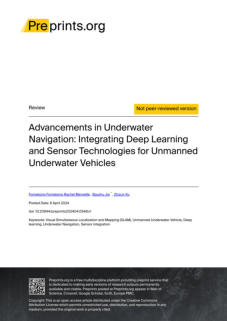

Author: Changho Yun
This paper advocates for the Underwater Multi-channel
Medium Access Control with Cognitive Acoustics
(UMMAC-CA) as an effective channel access protocol for
distributed underwater cognitive acoustic networks
(UCANs) by explaining the advantages of UMMAC-CA,
such as improved spectral efficiency, reduced channel
access overhead, and better performance metrics
compared to the existing Multi-channel Medium Access
Control with Cognitive Radios (MMAC-CR).

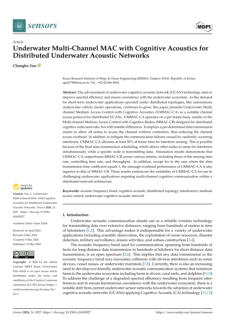

Author: Wenwei Zhang, Kun Zhu, Zhichun Yang, Yunling
Ye, Junfeng Ding, and Jin Gan
This study addresses the challenges of detecting
underwater damage to structures with pile foundations. It
introduces the design and evaluation of an adsorption-
operated robotic system equipped with an automatic
movement mechanism and a force-redeemed active
disturbance rejection controller. Additionally, it develops a
new detection algorithm based on the image
segmentation network UNet.

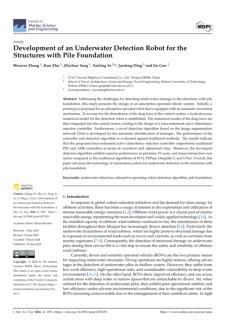

Author: Angelo Mari C. Paredes, & Edwin R. Arboleda
This study analyzes the challenges and advancements in
underwater communication for Underwater Wireless
Sensor Networks (UWSNs) by highlighting the difficulties
posed by the underwater environment, such as
attenuation, multipath propagation, and limited
bandwidth, and discusses how innovative antenna
designs can address these issues. It examines different
types of antennas (monopole, dipole, and helical), their
trade-offs, and advancements in materials and
reconfigurable antennas that offer promising solutions.

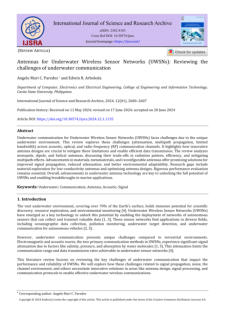

Authors:
Shuangquan Li, Zhichen Zhang, Qixian Zhang, Haiyang
Yao, Xudong Li, Jianjun Mi, & Haiyan Wang
This document reviews and analyzes recent
advancements in underwater optics, particularly focusing
on the challenges and developments in underwater
optical transmission. It highlights the importance of
understanding underwater optical laws and physical
models and their applications in various domains, such as
underwater resource exploration, autonomous
underwater vehicle navigation, and underwater wireless
optical communication. It also identifies future directions
and emphasizes the need for further research to enhance
underwater optical technologies and their applications.

